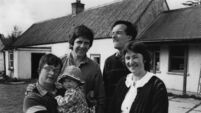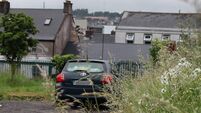Testimony: 'It is horrific to think that so many women still feel this pain'

A scene from Testimony, which will be released in cinemas on November 21
Telling the story of the mother & baby homes
From 1922 to 1996, thousands of Irish women were placed in Mother and Baby Homes, where many babies died and numerous others were forcibly given up for adoption.
These Magdalene Laundries became the incarnated homes of countless women forced to work long hours and suffer at the hands of the religious orders.
Aoife Kelleher, the film-maker behind the award-winning documentary Mrs Robinson, has dedicated many years to bringing her latest work, Testimony to the screen.
The documentary provides a compelling and comprehensive look into the campaign advocating for recognition of the suffering experienced by thousands in both Mother and Baby Homes and Magdalene Laundries.
Kelleher says one of the reasons she decided to make it was due to the stigma many survivors still feel.
One such woman is Madeleine Marvier, who was placed in Bessborough Mother and Baby Home in Cork when she was just 17, where she had a baby boy, William, who died shortly after he was born.
“I was amazed to discover that there is still a stigma,” Kelleher said.
“We met Madeleine’s daughter, Carmel, and spoke with her about the family’s desire for an inquest into William’s death.
“When I spoke to Madeleine, she was so emotional, and it was clear that she still felt stigmatised.
“She wanted to tell William’s story, but she was concerned about what her family would think. We spoke about the possibility of her taking part in the film but not facing the camera or having her name included; that was the extent of the stigma and shame.”
Kelleher says that despite events to honour the survivors and an outpouring of support from the Irish population, women are living not just with great pain and trauma from their experiences, but also with feelings of shame.
“It is horrific to think that so many women still feel this pain for something that wasn’t their fault.
“In Madeleine’s case, when we went to film, she decided that she wanted to tell her story, to have her name out there, and to have her face included in the documentary, which was wonderful.
“Since conducting the interview, she’s spoken publicly on multiple occasions, and I think it has been therapeutic for her.”
The documentary features women from various parts of the country, with a strong presence from Cork. Many women were placed in the Bessborough Mother and Baby Home, and the Sunday’s Well Magdalene Laundry.
Kelleher says that filming at Bessborough was difficult because, although it is known that many infants were buried there, there are no records of where exactly they were laid to rest.
“It is estimated that 923 children died in or after being transferred to the Bessborough Mother and Baby Home, and we know that 64 of the burial places have been established. The burial sites of 859 children are unknown. When you are walking through the grounds, you don’t know if you are walking on a burial site, and that stays with you while you are there.”
Marvier was told that her baby was buried in the grounds of Bessborough, but later found out that he was placed somewhere in Carr’s Hill Cemetery. She has yet to find out exactly where he was buried.
“We know that Madeleine’s son, William, was buried in a mass famine grave at a different location from what she had been told. She experienced a nun stomping her foot on the grounds of Bessborough, telling her, ‘This is where William was buried’.
“Later, Madeleine discovered he was in a very different location in a mass grave.
“When you are at Bessborough and similar locations, the sense of loss, grief and trauma is palpable.”
Another prominent contributor is Mari Steed, an ardent campaigner for survivors in Ireland and abroad. Steed, who was born in St Finbarr’s Hospital in Cork, lived with her mother, Josephine, in Bessborough for 18 months. She was given up for adoption to an American family without the consent of her mother.
Steed was the co-founder of Justice for Magdalenes Research as well as several other organisations. She died last year after a brief illness. Kelleher says her work as an activist was extraordinary.
“Mari was incredible. She spoke to survivors, taking them through the process of accessing information and redress.
“The work Mari was doing was truly significant for survivors, and it continued right up until her death.
“She is a great loss to Justice for Magdalene and survivors here and abroad. She was an extraordinary activist.”
There is a subtle use of reconstruction throughout the documentary. Kelleher says she was careful to use it sparingly and sensitively.
“With reconstruction, it’s crucial to be sensitive; you don’t want to sensationalise these stories. You want to be as accurate as possible.
“All of the reconstructions were based entirely on the testimony of our contributors.”
Kelleher hopes Testimony, which won awards at the Law Society of Ireland’s Justice Media Awards and the Dublin International Film Festival, will serve as a reminder that there is still much to be done on the issue.
“There is so much work to be done in relation to truth and reconciliation in Ireland and around the area of redress.
“There’s work to be done at places like Bessborough to protect that site for commemoration.
“That is why I wanted to make the film, to give people a platform to tell their stories, and to emphasise that there is still so much to be done.”
Testimony is released in cinemas on November 21, Cert: 12a.







